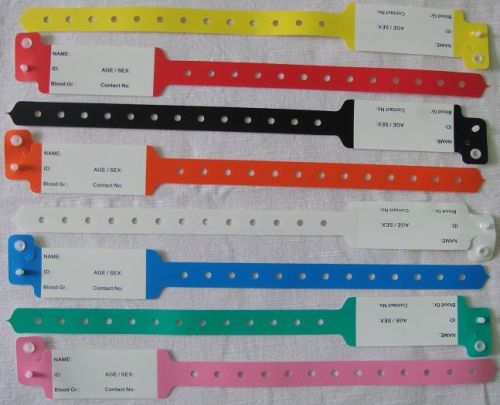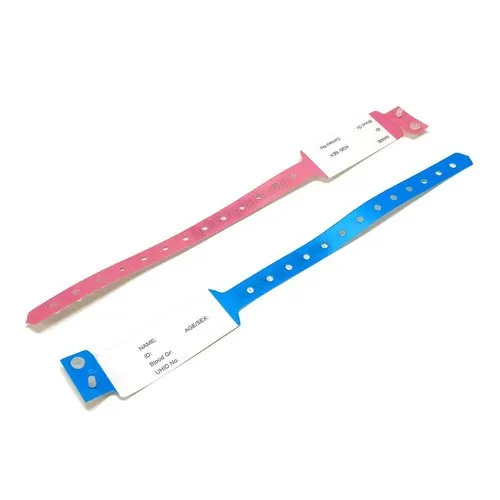How a Patient Identification Band Improves Patient Support and Reduces Dangers
How a Patient Identification Band Improves Patient Support and Reduces Dangers
Blog Article
Discovering the Various Sorts Of Patient Identification Band Made Use Of in Medical Facilities
In the elaborate globe of healthcare, the essential role of Patient Identification bands frequently goes undetected. These bands, varying from basic paper wristbands to advanced RFID bands, create the backbone of Patient safety methods, ensuring accuracy in Patient Identification. Yet, the vast variety of these bands, each with its distinct benefits and restrictions, is commonly overlooked. As we browse with this subject, one might get insight into the subtle complexities and important relevance of such bands in clinical centers.
Understanding the Importance of Patient Identification Bands
While they may seem like mere accessories, Patient Identification bands play an essential duty in clinical centers. These bands serve as an important device for validating Patient identification, avoiding medical errors associated to misidentification. Patient Identification bands likewise aid in improving administrative tasks, making sure precise record-keeping and invoicing.
Typical Paper Wristbands: Their Use and Limitations
Traditional paper wristbands have been a staple in Patient Identification across numerous clinical centers. While their use is extensive, they harbor particular constraints that might affect their performance in Patient administration. This section will concentrate on the extent of their application and the integral disadvantages related to their use.
Paper Wristbands: Usage Range
In the world of Patient Identification, paper wristbands have long held a critical role. These bands are generally utilized in outpatient setups, where the Patient's keep is short-lived. Despite developments in innovation, the simple paper wristband continues to be a dependable and affordable remedy for Patient Identification in numerous medical care circumstances.
Limitations of Paper Wristbands
Despite their prevalent use, paper wristbands are not without their downsides. In addition, paper wristbands commonly do not have the technological capabilities of more modern-day options, such as barcoding or RFID chips, restricting their functionality to just showing written info. Paper wristbands can cause pain or skin inflammation to some patients, particularly when put on for extended periods.
Barcoded Wristbands: Advancements in Patient Identification
While Patient Identification has actually long been a crucial element of health care, the introduction of barcoded wristbands symbolizes a substantial jump ahead. These bands utilize the simpleness of barcoding modern technology, permitting for Patient info to be swiftly scanned and accessed. They improve the rate and accuracy of Patient Identification, reducing the risk of clinical mistakes connected to misidentification.
Superhigh Frequency Identification (RFID) Bands: an Action Towards Futuristic Healthcare
The evolution of Patient Identification bands has actually brought regarding the introduction of Superhigh frequency Identification (RFID) Bands (patient identification band). These innovative tools existing crucial advantages for health care facilities, offering an extra effective and technically advanced means of Patient Identification. The execution of RFID in health care is a considerable step towards a more advanced approach to Patient management and safety
Comprehending RFID Bands

RFID Bands: Trick Benefits
Embracing a future where modern technology and medical care combine, superhigh frequency Identification bands provide several vital benefits. Mostly, these bands enhance Patient safety and security by giving precise, instant Identification, therefore lowering medical errors. RFID bands can save a huge amount of Patient information, including case history and allergies, enabling individualized treatment. They also simplify management tasks, as the automated information entrance replaces hand-operated processes, improving performance and minimizing paperwork. Furthermore, RFID bands supply real-time tracking of patients, important in high-risk settings such as surgical treatment or intensive treatment. These bands are resistant and long lasting to ecological elements, making certain constant capability. Generally, RFID bands stand for a considerable advancement in Patient Identification modern technology, profiting both people and doctor.
Carrying Out RFID in Medical Care
As we enter a technically innovative period, the execution of RFID bands in medical care comes to be significantly essential. These bands give a smooth means to track and recognize people, guaranteeing their security and enhancing effectiveness in treatment procedures. RFID bands provide various advantages over traditional Identification approaches. They can save a huge amount of data, including the Patient's case history and therapy plans, which can be easily accessed by doctor. This information aids physicians make notified decisions regarding the Patient's treatment strategy. RFID bands decrease clinical mistakes by providing exact Patient Identification, which is critical in stopping misdiagnosis or wrong medicine management. Thus, the execution of RFID bands is a considerable step in the direction of improving Patient security and medical care shipment.

Color-Coded Wristbands: Helping in Quick and Accurate Diagnosis
In the busy setting of a clinical facility, color-coded wristbands have actually arised as vital tools for swift and exact Identification of see post an individual's clinical problem. These wristbands, put on by people, bring details colors that match to different clinical conditions or conditions. Red might show allergy threats, while yellow may signify a loss danger. This system is designed to supply instant visual hints to doctor, image source enhancing Patient safety and care top quality. In emergency scenarios, using these wristbands permits for fast decision-making. The performance of color-coded wristbands depends on the uniformity of shade interpretation throughout healthcare organizations, requiring typical standards for regular application.
Strategies for Efficient Execution and Administration of Patient ID Bands
Attaining optimal use Patient Identification bands necessitates a well-structured method for their execution and administration. The primary step involves training all wellness personnel on the importance of properly applying and checking out these bands. Health centers need to standardize the use of ID bands across all departments, making sure harmony and lowering discrepancies. Normal audits needs to be performed to validate adherence to plans and to rectify any type of incongruities. Patient education is also important; clients need to comprehend the purpose of the bands and the need for their constant wear. patient identification band. Last but not least, it's necessary to have a back-up strategy in position, such as barcode scanning or biometrics, to guarantee that Patient Identification is never compromised.
Verdict
Patient Identification bands are crucial in clinical facilities to make certain security and precision. Standard paper, barcoded, RFID, and color-coded wristbands each hold distinct benefits, ranging from cost-effectiveness to innovative information storage space and instantaneous clinical informs. Efficient execution and administration of these bands can substantially decrease medical errors, enhance effectiveness, and boost overall Patient treatment. Thus, understanding and using these Identification devices is extremely important for preserving high criteria in healthcare.
These bands, varying from easy paper wristbands to sophisticated RFID bands, develop the foundation of Patient security procedures, making certain accuracy in Patient Identification.The advancement of Patient Identification bands has actually brought concerning the appearance of Radio Regularity websites Identification (RFID) Bands. On the whole, RFID bands stand for a substantial advancement in Patient Identification modern technology, profiting both people and medical care providers.
RFID bands reduce medical mistakes by giving exact Patient Identification, which is important in avoiding misdiagnosis or wrong medication administration. Patient education and learning is likewise important; clients need to comprehend the purpose of the bands and the need for their constant wear.
Report this page